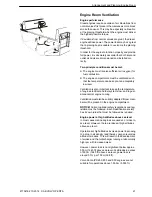
Pitting corrosion
Pitting corrosion can occur on stainless steel and alu-
minum. The attack is caused by localized breakdown
of the passive oxide film on the metal surface. In nat-
ural water, it is generally chloride ions that initiate the
attack. The risk increases with rising water tempera-
tures. There is a number of aluminum alloys with very
good resistance to corrosion by seawater. If these are
connected together with more noble metals, they will
be attacked due to galvanic corrosion, however.
Very high levels of chromium and molybdenum are
required, above all, to make stainless steel fully resist-
ant to the risk of pitting corrosion. If there is weak
cathodic protection (sacrificial anodes), excellent pro-
tection against pitting corrosion can be obtained on
simpler steels. Alloys of lower grades than 316 should
be avoided, however.
Crevice corrosion
An attack in the gap between two metal surfaces, or
between one metal surface and another materials is
called crevice corrosion. A so-called oxygen depletion
cell is formed when oxygen transport into the crevice
is lower than oxygen transport out to the cell opening.
Separate anodic and cathodic surfaces are formed.
The cathodic process, which requires access to oxy-
gen, is formed in the gap opening and the anodic proc-
ess, metal dissolving, takes place inside the gap. Crev-
ice corrosion can occur on most metals, but the risk is
greatest on metals that can be passivated, such as
aluminum and stainless steel.
Deposit corrosion is closely related to crevice corro-
sion. It takes place under deposits and marine fouling
such as barnacles.
p0011419
p0011420
Arrangement and Planning, Electrochemical Corrosion
47704162 10-2014 © AB VOLVO PENTA
35
Summary of Contents for IPS650
Page 1: ...IPS 2 IPS650 IPS800 IPS950 Installation 1 1 E ...
Page 2: ......
Page 156: ......
Page 160: ...47704162 English 10 2014 ...






























